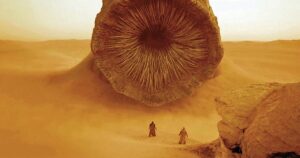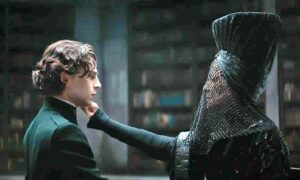 By Steve Crum
By Steve Crum
Who would have thought I would at all be fascinated by an epic movie based on a 1965 sci-fi novel, written by Frank Herbert, that spins an involved tale that begins with Duke Leto of House Atreides—of the ocean planet Caladan—being assigned to replace House Harkonnen as fief ruler of Arrakis…to control the lucrative (awk!) SPICE production?
Neither had I ever read the essential (for true sci-fi fans) Herbert novel, Dune, NOR watched the reportedly disappointing 1984 film adaptation….also titled Dune. So why am I now driven to wildly applaud this 156-minutes of otherworldly, ultra escape—a flick I have been purposely avoiding since its inception?
ANSWER: Because this movie version of Dune (aka Dune: Part One) directed and co-written by Denis Villeneuve, has so enveloped my thoughts and dreams (at least one night, anyway) that I now give up. It has grabbed me in ways never felt since the first time I saw Star Wars during the summer of 1977. Let’s call Dune: Part One a deeply thinking person’s Star Wars.
Maybe I just love the giant sandworms of Dune because I groove on the sarlacc in Revenge of the Jedi. But there must be more to my Dune  “thing” than one scary creature.
“thing” than one scary creature.
Indeed, there are other reasons.
The paramount attractions, the visuals, connect immediately. The landscapes, costuming, sets, makeup, creatures, and wild special effects are stunning. So awesome are they that of Dune’s 10 Oscar noms, four won for Cinematography, Visual Effects, Production Design and Editing. Factor in two more wins for the Sound and Hans Zimmer’s Score.
Kudos to screenwriters Jon Spaihts, Eric Roth, and Villeneuve for balancing the challenging work with a cohesive story line.
 Basically, the epic tale is one of political power and corruption set way into the future. (Egad, have we no hope of someday living in a society devoid of such strife?) Families are pitted against families, and planets against planets. Good and evil exist as do loyalty and deception. These are themes common to any literary structure in which—of course—conflict must exist. In Dune, the conflicts are often spectacularly shown (huge battles) or shadowy (Paul Atreides, played by Timothée Chalamet, being groomed as a potential leader).
Basically, the epic tale is one of political power and corruption set way into the future. (Egad, have we no hope of someday living in a society devoid of such strife?) Families are pitted against families, and planets against planets. Good and evil exist as do loyalty and deception. These are themes common to any literary structure in which—of course—conflict must exist. In Dune, the conflicts are often spectacularly shown (huge battles) or shadowy (Paul Atreides, played by Timothée Chalamet, being groomed as a potential leader).
Mysticism and foreboding are major ingredients as well.
Topping or at least equalling it all, is an international cast of impressive actors. Some of their characters will not make it to Dune: Part Two, to  be released Oct. 20, 2023. (That is, unless they are somehow brought back from death.) Of course, I will not divulge who survives here.
be released Oct. 20, 2023. (That is, unless they are somehow brought back from death.) Of course, I will not divulge who survives here.
Representing the lengthy list of actors, their characters are included to represent the complex and transcendental language.
The relatively brief list includes a Spell Check nightmare of Rebecca Ferguson as Lady Jessica Atreides, the ducal heir; Oscar Isaac (Duke Leto Atreides); Josh Brolin (Gurney Halleck); Stellan Skarsgård (Baron Vladimir Harkonnen); Stephen McKinley Henderson (Thufir Hawat, the Mentat); Zendaya (Chani, a mysterious Fremen woman); Javier Bardem (Stilgar, Fremen leader);  and Jason Momoa (Duncan Idaho, sword master of House Atreides).
and Jason Momoa (Duncan Idaho, sword master of House Atreides).
It’s a far, far cry from Luke and Leia.
∞∞∞∞∞
GRADE on an A-F Scale: A
